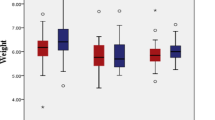Summary
In this article, rank-based methods are developed for analyzing unbalanced one-way repeated measures data. It is assumed that errors within each subject are exchangeable random variables.R-estimates of the treatment effects are obtained by minimizing a piecewise linear function. Rank-based methods are developed for testing the equality of the treatment effects. An unbalanced data set is analyzed for illustrative purposes. The relative efficiency of theR-estimates and maximum likelihood estimates is discussed. A small scale simulation study, comparing powers and sizes of the rank-based tests and normal theory tests (e.g., Wald and F), is presented.
Similar content being viewed by others
References
Andrews, D. M. andDavid, H. A. (1990), Nonparametric analysis of unbalanced paired comparison of ranked data.Journal of the American Statistical Association, 85, 1140–1146.
Benard, A. andvan Elteren, Ph. (1953), A generalization of the method ofm rankings.Indagationes Mathematicae, 15, 358–369.
Bloch, D. A. andGastwirth, J. S. (1968), On a simple estimate of the reciprocal of the density function.Annals of Mathematical Statistics, 39, 1083–1085.
Crowder, M. J. andHand, D. J. (1990),Analysis of Repeated Measures. London: Chapman & Hall, 73.
Jaeckel, L. A. (1972), Estimating regression coefficients by minimizing the dispersion of residuals.Annals of Mathematical Statistics, 43, 1449–1458.
Olsson, R. (1974), A sequential simplex for solving minimization problems.Journal of Quality Technology, 6, 53–57.
Prentice, M. J. (1979), On the problem ofm incomplete rankings.Biometrika, 66, 167–170.
Rashid, M. M. (1995), Analysis of repeated measures incomplete block designs usingR-estimators.Statistics and Probability Letters, 22, 213–221.
Searle, S. R. (1987),Linear Models for Unbalanced Data, New York: John Wiley & Sons, Inc.
Shapiro, S. S. andWilk, M. B. (1965), Analysis of variance test, for normality and complete samples.Biometrika, 52, 592–611.
Skillings, J. H. andMack, G. A. (1981), On the use of Friedman type statistic in balanced and unbalanced block design.Technometrics, 23, 17–177.
Author information
Authors and Affiliations
Additional information
The views expressed in this article are those of the author and not those of the United States Food and Drug Administration.
Rights and permissions
About this article
Cite this article
Rashid, M.M. Comparisons of rank-based methods and normal theory methods for unbalanced one-way repeated measures data. J. Ital. Statist. Soc. 9, 199–218 (2000). https://doi.org/10.1007/BF03178966
Issue Date:
DOI: https://doi.org/10.1007/BF03178966




